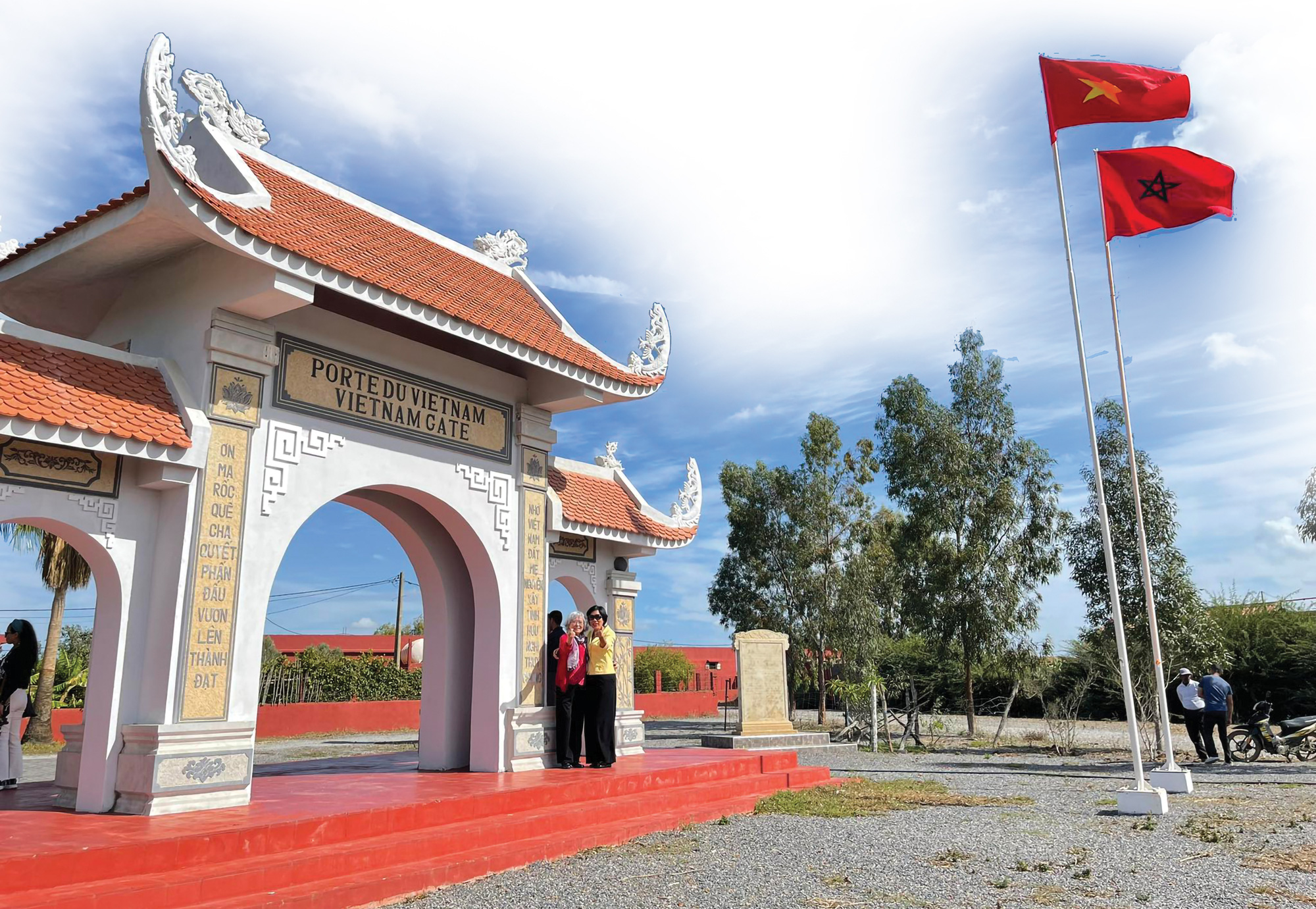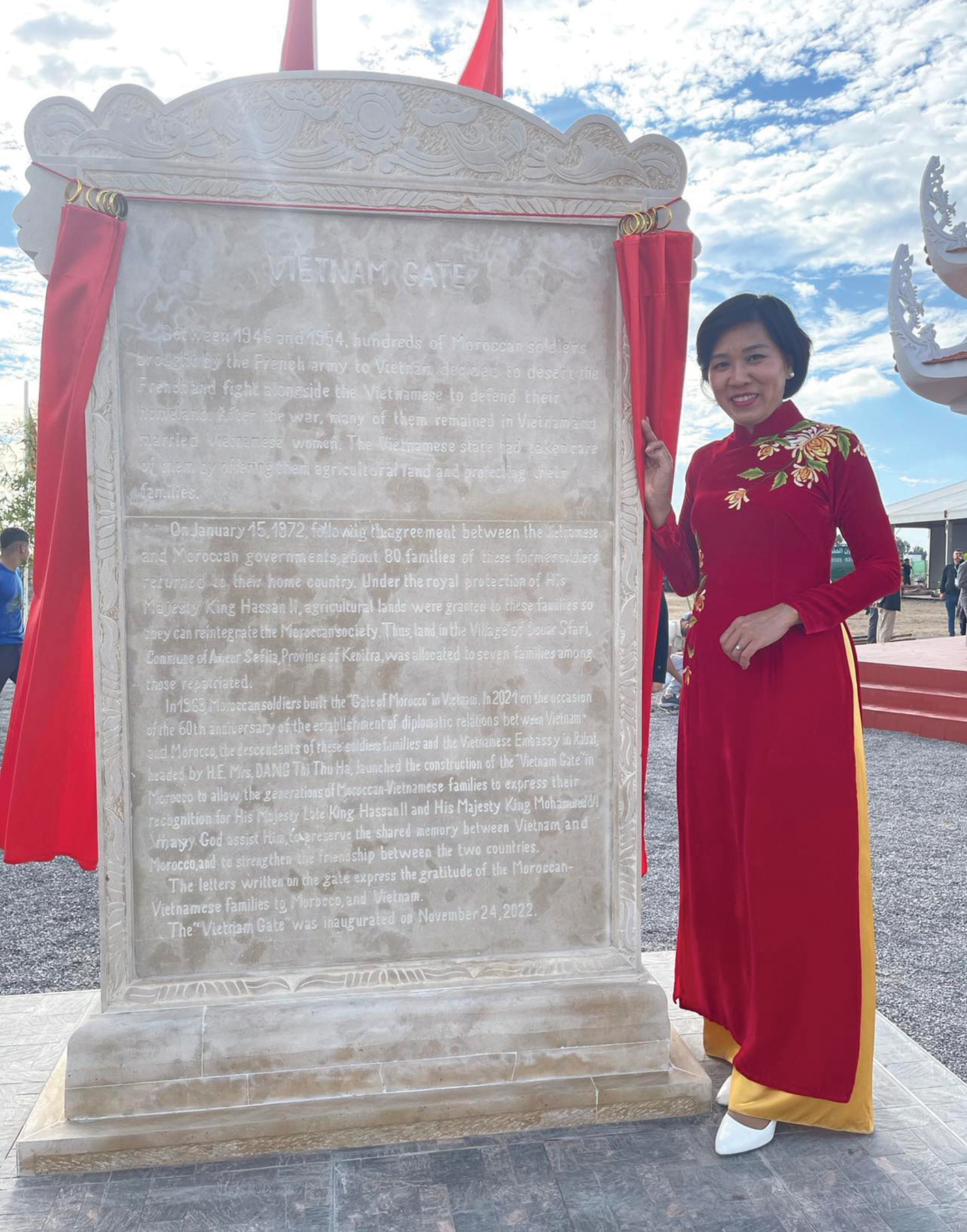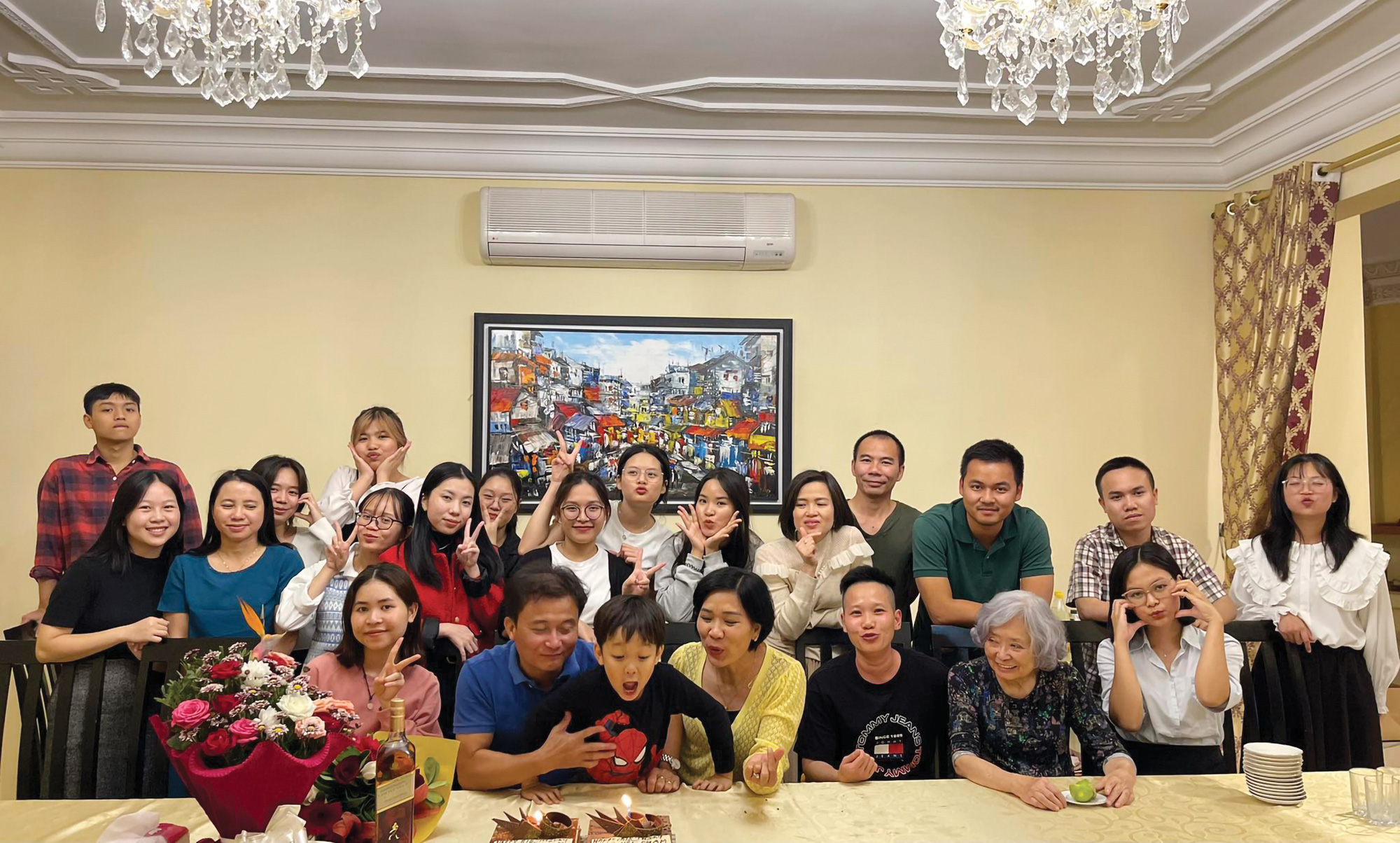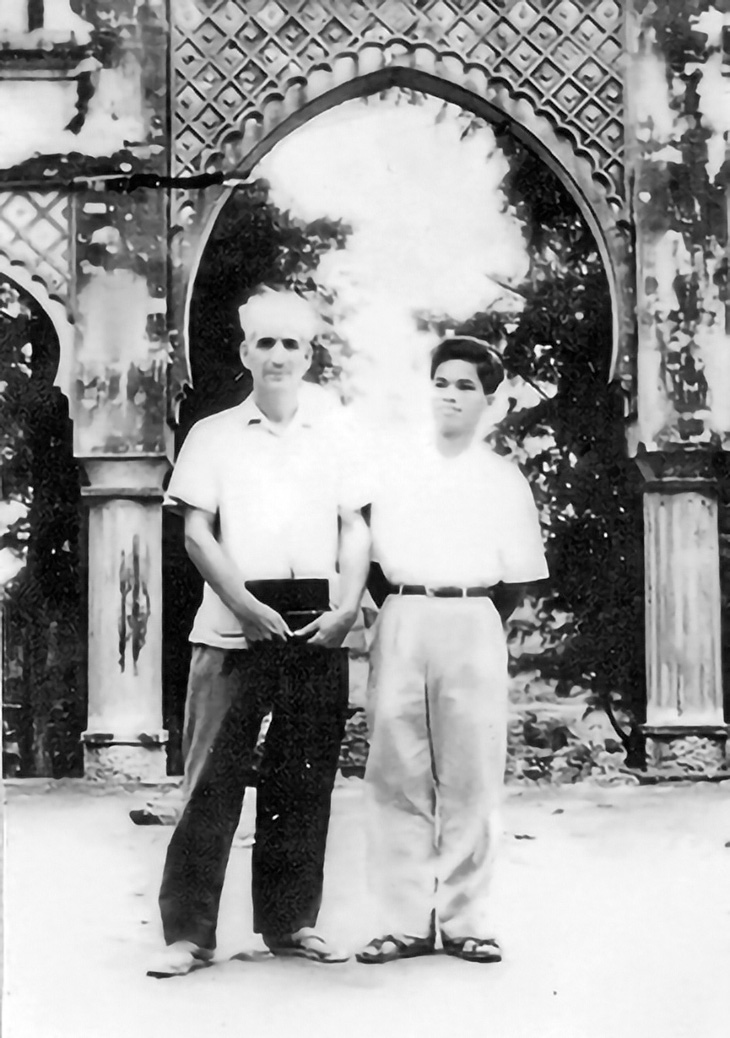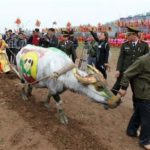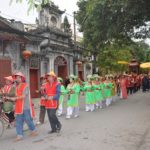War correspondent and activist, 82-year-old Tran To Nga, shares her unexpected journey to Morocco, where she connected with a vibrant Vietnamese community.
I was honored to receive an invitation from the charming Vietnamese Ambassador to Morocco, Dang Thi Thu Ha, just before the conclusion of her four-year term. My trip to Morocco was unplanned, but those four days turned out to be incredibly enriching and offered me a unique perspective on Vietnam in the heart of North Africa.
A Gate to Culture
For the first time, I stepped into an embassy and was treated to a delicious meal of homemade pork intestines, prepared by the embassy officials themselves. I was captivated by the ambassador’s passionate story about the village gate, a collaborative effort between herself, the Vietnamese community in Morocco, and the supportive Moroccan people.
A Vietnam village gate in a foreign land! And not just any country, but a Muslim country like Morocco. Such a sight is rare, even in modernizing Vietnam, where village gates are becoming a scarce part of the landscape.
In Douar Sfari, a suburb of Kenitra City, stands this unique gate, adorned with two red flags – one bearing a yellow star and the other, a green star, fluttering proudly in the wind. Flanking the gate are two sentences, a pledge to honor both Vietnam and Morocco, aiming to strengthen bonds and celebrate success in both nations.
The construction of this gate was no small feat. Ambassador Thu Ha had to undergo approval procedures from both Vietnamese and Moroccan authorities, with direct involvement from grassroots to municipal levels. Even the materials, such as tiles and ridge beasts, were specially brought over from Vietnam.
The gate is situated where the first seven Vietnamese families settled in Morocco 50 years ago. Back then, the village lacked electricity, and the dirt road turned impassable for cars during rainy days. The dedication of the ambassador and officials was evident as they commuted 100 kilometers weekly to oversee the project.
On the inauguration day (November 24, 2022), over 600 guests gathered to celebrate this special occasion. I was privileged to travel in a diplomatic car to visit the village gate, where well-maintained roads and year-round electricity stood in stark contrast to the past.
As emotions ran high, I witnessed the red flag with a yellow star flying alongside the Moroccan flag, a beautiful symbol of the two nations.
|
|
| Vietnamese Ambassador to Morocco, Dang Thi Thu Ha, stands next to the stele, explaining the story of the Vietnam gate. Photo: Supplied |
Honoring Vietnamese traditions, the ambassador and her officials expressed gratitude to the heavens and the earth for their accomplishments over the past four years. As they bid farewell to Morocco, they did so with a sense of pride, knowing they had left a lasting impression on both the Vietnamese and Moroccan communities.
Within the Vietnamese community in Morocco, the daughter of Nhung, who accompanied her husband to this African country half a century ago, erected a miniature Vietnam gate at her home’s entrance. This gesture brought joy to her mother, and she encouraged other families to follow suit, fostering a sense of cultural identity.
This initiative contributes to the development of a distinct Vietnamese village in Morocco, reflecting a strong commitment to preserving their cultural roots.
Vietnamese Women: Pillars of the Community
The roots of the Vietnamese community in Morocco go back to 1972. During Vietnam’s resistance war against France, many French soldiers and those from the French Foreign Legion surrendered and later engaged in peacekeeping efforts, earning them the name ‘peace soldiers.’ Some of these soldiers married Vietnamese women and started families.
In 1972, the King of Morocco granted them permission to return home, and they brought their wives and children with them. In Al-Shinwa, a village in Kenitra, seven original Vietnamese families were allocated land by the king, providing them with a means of livelihood. Over time, subsequent families dispersed to other cities like Casablanca and Marrakech.
The Vietnamese women brought with them the vitality, courage, and industrious spirit of their homeland. They cultivated gardens, established villages, and passed on Vietnamese customs and traditions to their descendants. While subsequent generations primarily speak Arabic and French, many still understand basic Vietnamese and maintain a strong connection to their maternal roots.
I had the pleasure of meeting elderly women in their 80s, along with their children and grandchildren, all of whom greeted me in Vietnamese before exchanging the European tradition of three kisses. One such encounter was with Minh, a 90-year-old woman who immediately asked, “Can you still speak Vietnamese?” Her question created an instant bond between us.
Minh shared her experiences of raising five children in a foreign land, facing language barriers, and a husband who preferred to live off the king’s allowance. She sought help from female acquaintances, and together, they built a support network. Minh took on various jobs, both in France and beyond, to provide for her children. Her guiding principle was to maintain dignity and pride, no matter the challenges.
At 90, Minh takes immense pride in her accomplishments: raising six children, restoring her ancestors’ graves in Vietnam, and supporting her relatives. She takes care of herself using natural remedies and maintains her appearance with homemade beauty treatments. Despite her husband’s remarriage and eventual illness, Minh graciously cared for him and handled his funeral arrangements, even preparing a whole cow for guests who came to pay their respects.
Her unwavering compassion and resilience left a lasting impression on her neighbors, embodying the very spirit of Vietnam.
|
|
| Overseas Vietnamese students visit the Vietnamese Embassy in Morocco, a hub of cultural exchange. Photo: Supplied |
In addition to Minh, there are also Hien and Nhung, who left their hometowns in the 1970s to accompany their husbands to Morocco. Despite their children dispersing to various places, they always reunite during Tet and on death anniversaries. These women instill in their descendants a deep respect for their Vietnamese heritage, ensuring they remain compassionate and culturally aware.
During Tet, the village comes together to make traditional offerings, such as banh chung, sticky rice, and boiled chicken. These ladies also prepared a suitcase filled with lemongrass, guava leaves, and papaya leaves for me to bring back to France, a testament to their kindness and generosity.
I returned to France with these treasures and a mission to share the story of the vibrant Vietnamese community in this North African country with people back home.
A Symbol of Friendship: The Morocco Gate in Hanoi
During the resistance war against the French in Vietnam (1946-1954), thousands of African legionnaires, including Moroccans, deserted their French troops and joined the Vietnamese army. After the historic Dien Bien Phu Victory in 1954, a Vietnam-Africa plantation was established in Ba Vi District, Hanoi, welcoming 300 former Moroccan legionnaires. Many of them married local women and settled down, making Vietnam their new home.
In 1960, they constructed a grand gate in the classic Moroccan style, with arches, pillars, and decorative reliefs. This gate symbolized their nostalgia for their homeland and their commitment to forging a new life in Vietnam. Today, it stands proudly at the base of Ba Vi Mountain, a lasting legacy of their time in Vietnam.
|
|
| Nghiem Huu Phuc (R), a former officer, stands with a former African legionnaire at the Morocco Gate in Ba Vi, a symbol of friendship between the two nations. Photo: Nhan Dan Newspaper |
Sam Son sea festival slated for April 21
The 2018 sea festival of Sam Son city of the north central coastal province of Thanh Hoa will take place on April 21, heard a press conference held in the city on April 12.

